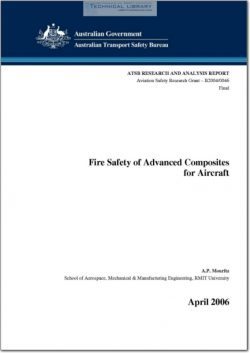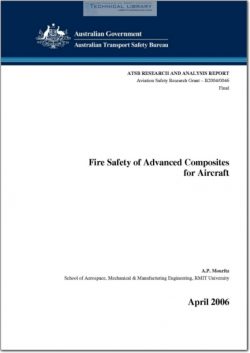ATSB-B2004-0046

- Version
- 185 Downloads
- 1.68 MB File Size
- 1 File Count
- August 9, 2016 Create Date
- August 9, 2016 Last Updated
Fire Safety of Advanced Composites for Aircraft

This report assesses the fire hazard of current and next—generation polymer composites for aircraft,
and identifies those materials with improved flammability resistance. A comprehensive review of
the scientific literature was performed to develop a database on the fire properties of a large number
of polymer composite materials. For both aircraft cabin materials and aircraft structural materials
the following fire properties were considered in the determination of fire safety: time-to-ignition,
limiting oxygen index, peak heat release rate, average heat release rate, total heat release, flame
spread rate, smoke, and combustion gases. The data is presented as performance tables which rank
the composite materials in order from best to worst.
The composite most often used in pressurised aircraft cabins is glass/phenolic, and the database
shows that this material has excellent fire reaction performance and that very few next-generation
composites display superior properties. The most used structural composite is carbon/epoxy, and
this material has poor fire resistance and can pose a serious fire hazard. A number of advanced
structural composites with superior fire properties are identified, including materials with high
temperature thermoset polymer, thermoplastic or inorganic polymer matrices.
Fire contributes to aircraft accidents and many fatalities. The growing use of
polymer composite materials in aircraft has the potential to increase the fire hazard
due to the flammable nature of the organic matrix.
The polymer composite most often used in the external structures of aircraft is
carbon/epoxy, which is a flammable material that easily ignites and burns when
exposed to fire. A large percentage of the cabin interior of wide—bodied passenger
aircraft is made using composite materials, mostly glass/phenolic. Phenolic
composites have good flammability, but newer materials are being developed that
offer the promise of increasing the fire safety of aircraft cabins. In fact, a large
number of new composite materials are being developed for cabins and external
structures that have the potential to increase the fire safety of aircraft, but a detailed
analysis of the fire performance of these materials against conventional materials
now used in aircraft has not been performed. Such an evaluation will provide a
clear indication of the potential improvements in fire safety by using new fire
resistant composites in aircraft.
| File | Action |
|---|---|
| ATSB-B2004-0046 Fire Safety of Advanced Composites for Aircraft.pdf | Download |

Comment On This Post